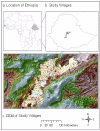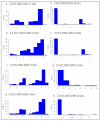Spatial analysis of malaria incidence at the village level in areas with unstable transmission in Ethiopia
- PMID: 19171051
- PMCID: PMC2646707
- DOI: 10.1186/1476-072X-8-5
Spatial analysis of malaria incidence at the village level in areas with unstable transmission in Ethiopia
Abstract
Background: Malaria is the leading cause of morbidity and mortality in Ethiopia, accounting for over five million cases and thousands of deaths annually. The risks of morbidity and mortality associated with malaria are characterized by spatial and temporal variation across the country. This study examines the spatial and temporal patterns of malaria transmission at the local level and implements a risk mapping tool to aid in monitoring and disease control activities.
Methods: In this study, we examine the global and local patterns of malaria distribution in 543 villages in East Shoa, central Ethiopia using individual-level morbidity data collected from six laboratory and treatment centers between September 2002 and August 2006.
Results: Statistical analysis of malaria incidence by sex, age, and village through time reveal the presence of significant spatio-temporal variations. Poisson regression analysis shows a decrease in malaria incidence with increasing age. A significant difference in the malaria incidence density ratio (IDRs) is detected in males but not in females. A significant decrease in the malaria IDRs with increasing age is captured by a quadratic model. Local spatial statistics reveals clustering or hot spots within a 5 and 10 km distance of most villages in the study area. In addition, there are temporal variations in malaria incidence.
Conclusion: Malaria incidence varies according to gender and age, with males age 5 and above showing a statistically higher incidence. Significant local clustering of malaria incidence occurs between pairs of villages within 1-10 km distance lags. Malaria incidence was higher in 2002-2003 than in other periods of observation. Malaria hot spots are displayed as risk maps that are useful for monitoring and spatial targeting of prevention and control measures against the disease.
Figures








References
-
- WHO/UNICEF . The world malaria report 2005. Geneva: World Health Organization; 2005.
-
- Snow RobertW, Marsh Kevin. The consequences of reducing transmission of Plasmodium falciparum in Africa. Adv Parasitol. 2002;52:235–264. - PubMed
-
- Kiszewski AE, Tekelehaimanot A. A review of the clinical and epidemiologic burdens of epidemic malaria. Am J Trop Med Hyg. 2004;71:128–135. - PubMed
-
- WHO/UNICEF . The Africa Malaria Report 2003. World Health Organization/UNICEF; 2003.
Publication types
MeSH terms
LinkOut - more resources
Full Text Sources
Medical

